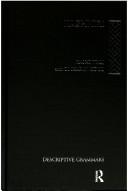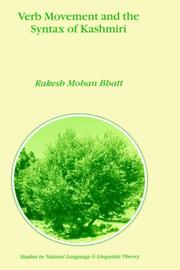| Listing 1 - 10 of 10 |
Sort by
|
Book
ISBN: 818555787X 9788185557878 Year: 1993 Publisher: Delhi : Delhi : Low Price Publications, D.K. Publishers' Distributors,
Abstract | Keywords | Export | Availability | Bookmark
 Loading...
Loading...Choose an application
- Reference Manager
- EndNote
- RefWorks (Direct export to RefWorks)
Book
ISBN: 9783869770406 3869770406 Year: 2012 Publisher: Halle: Universitätsverlag Halle-Wittenberg,
Abstract | Keywords | Export | Availability | Bookmark
 Loading...
Loading...Choose an application
- Reference Manager
- EndNote
- RefWorks (Direct export to RefWorks)
The present volume is a collection of textual studies on various features of the history and culture of Kashmir. It is mainly based on revised versions of lectures delivered at a "Kashmir panel" held at the 31st German Oriental Conference (DOT) in Marburg in 2010. It deals with the transfer of India’s sacred geography to the highlands of Kashmir in a miniaturized form, a previously unnoticed recording of an appearance of Halley’s Comet in Kashmir by the poet-historian Śrīvara, the historical traces of vocal and instrumental music (saṅgīta) in Kashmir, as well as with the poetical figure bhāṣāśleṣa (simultaneous expression of different meanings in two or more languages) as a peculiarity of Kashmiri writers and critics. Further subjects are the formation of a specifically Kashmiri literary genre— the Kashmiri kathā—and the development of a special style connected to it, and the question, when, where and why did Bhaṭṭa Jayanta write his Nyāyamanjarī. A collection of four contributions, dealing with different aspects of the Mokṣopāya/Yogavāsiṣṭha literature, completes the volume.
Book
Year: 1923 Publisher: London : J. Murray,
Abstract | Keywords | Export | Availability | Bookmark
 Loading...
Loading...Choose an application
- Reference Manager
- EndNote
- RefWorks (Direct export to RefWorks)
Kashmiri language --- Folklore --- Folk literature --- Themes, motives.
Book
Year: 1975 Publisher: Mysore : Central Institute of Indian Languages,
Abstract | Keywords | Export | Availability | Bookmark
 Loading...
Loading...Choose an application
- Reference Manager
- EndNote
- RefWorks (Direct export to RefWorks)
Hindi language --- Kashmiri language --- Glossaries, vocabularies, etc.

Abstract | Keywords | Export | Availability | Bookmark
 Loading...
Loading...Choose an application
- Reference Manager
- EndNote
- RefWorks (Direct export to RefWorks)
Indo-European languages --- Grammar --- Kashmiri language --- Kashmiri (langue) --- Grammaire --- Grammaire. --- Grammar.
Book
Year: 1919 Publisher: Calcutta Office of the superintendent of government printing, India
Abstract | Keywords | Export | Availability | Bookmark
 Loading...
Loading...Choose an application
- Reference Manager
- EndNote
- RefWorks (Direct export to RefWorks)
India -- Languages
India --- Language and languages --- Indo-Aryan languages [Modern ] --- Sindhi language --- Lahndýa language --- Siraiki Hindki dialect --- Pisacha languages --- Kashmiri language
Book
ISBN: 9004346783 9789004346789 9789004346772 9004346775 Year: 2017 Publisher: Leiden ; Boston : Brill,
Abstract | Keywords | Export | Availability | Bookmark
 Loading...
Loading...Choose an application
- Reference Manager
- EndNote
- RefWorks (Direct export to RefWorks)
Argument structure of Kashmiri is a study of the grammatical patterns one finds in the Indo-Aryan language Kashmiri. Kashmiri shows several unique linguistic features which sets it aside from more well-known Indo-Aryan languages. The book focuses on the grammatical relations and their coding in case marking and in verb agreement. The occurrence of pronominal suffixation in Kashmiri is related with the universal feature of referential hierarchies and the phenomenon of verb second word order. The grammatical structure of Kashmiri is situated in the linguistic area of the Himalayas, and minority languages in the area are discussed as well. The book draws on a wealth of examples from field work, local manuscripts and secondary sources and it is a first comprehensive overview of the grammatical features of Kashmiri from a typological point of view.
Kashmiri language --- Cashmeeree language --- Cashmiri language --- Kacmiri language --- Kaschemiri language --- Kāšur language --- Keshur language --- Dardic languages --- Suffixes and prefixes. --- Verb.
Book
Year: 1968 Publisher: Dordrecht : D. Reidel,
Abstract | Keywords | Export | Availability | Bookmark
 Loading...
Loading...Choose an application
- Reference Manager
- EndNote
- RefWorks (Direct export to RefWorks)
Be (The English word) --- Grammar, Comparative and general --- Japanese language --- Kashmiri language --- Armenian language --- Hungarian language --- Sumerian language --- Shona language --- Verb. --- Verb

ISBN: 0792360338 Year: 1999 Publisher: Dordrecht Kluwer
Abstract | Keywords | Export | Availability | Bookmark
 Loading...
Loading...Choose an application
- Reference Manager
- EndNote
- RefWorks (Direct export to RefWorks)
Grammar, Comparative and general --- Kashmiri language --- Grammar, Comparative and general Syntax --- Syntax --- Cashmeeree language --- Cashmiri language --- Kacmiri language --- Kaschemiri language --- Kāšur language --- Keshur language --- Dardic languages --- Linguistics --- Philology --- Verb --- Syntax. --- Verb.
Book
ISBN: 1283174936 9786613174932 902728699X 9789027286994 9781283174930 9789027208217 9027208212 Year: 2011 Publisher: Amsterdam ; Philadelphia : John Benjamins,
Abstract | Keywords | Export | Availability | Bookmark
 Loading...
Loading...Choose an application
- Reference Manager
- EndNote
- RefWorks (Direct export to RefWorks)
This research monograph is an investigation of wh-movement and wh-expletive constructions in the Indic languages Kashmiri and Hindi-Urdu. It advances a novel theory of the periphery, or the clausal positions that mediate A-bar movement. In particular, a detailed study of wh-expletives and wh-expletive constructions reveals an underlying similarity of design between the A and A-bar systems, and indicates that the two can be understood as driven by the same basic set of mechanisms. The monograph offers an account of wh-movement and the clausal periphery in the two languages, informed by the latest strands of research on the syntax and semantics of A-bar movement. This micro-comparative analytical method yields an important result: we can understand a set of systematic contrasts between the two languages in terms of the properties of specifically the phase-defining heads C and v. Empirically, this work explores the lesser-studied language Kashmiri, bringing to the fore linguistic data not yet discussed in formal syntactic literature. The significance of these data for the development of the wider theoretical framework is stressed throughout, making the book of substantial interest for general linguistic research.
Grammar, Comparative and general --- Kashmiri language --- Hindi language --- Urdu language --- Bihari language (Urdu) --- Gujri language --- Gurjari language --- Islami language --- Moorish language (India) --- Undri language --- Urudu language --- Hindustani language --- Cashmeeree language --- Cashmiri language --- Kacmiri language --- Kaschemiri language --- Kāšur language --- Keshur language --- Dardic languages --- Language and languages --- Syntax --- Syntax. --- Linguistics --- Philology --- Grammar, Comparative and general Syntax
| Listing 1 - 10 of 10 |
Sort by
|

 Search
Search Feedback
Feedback About UniCat
About UniCat  Help
Help News
News